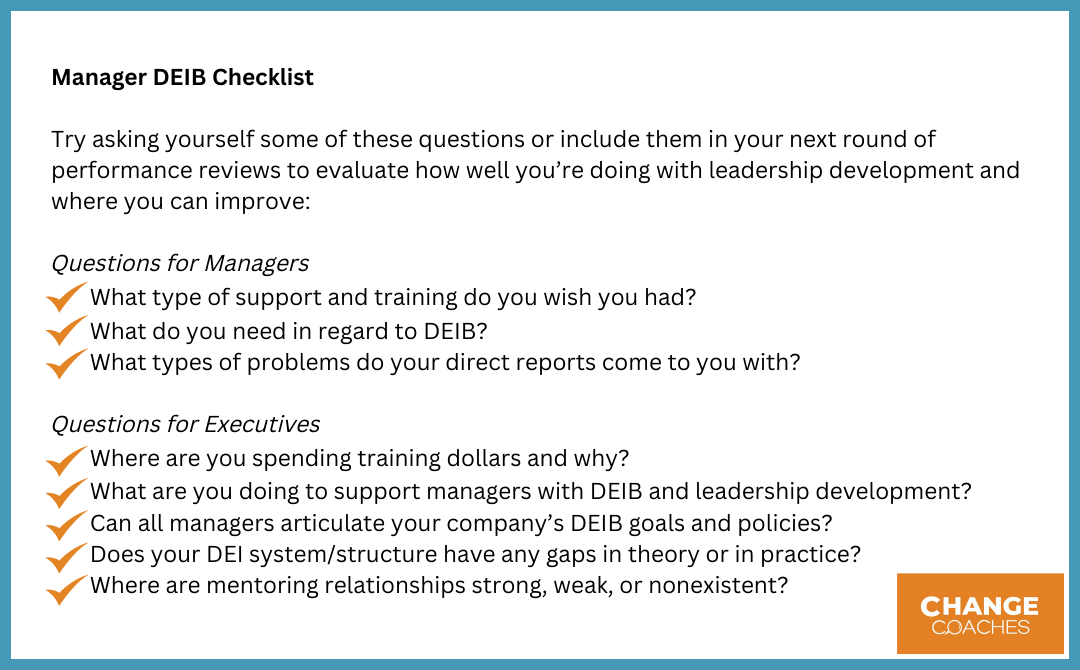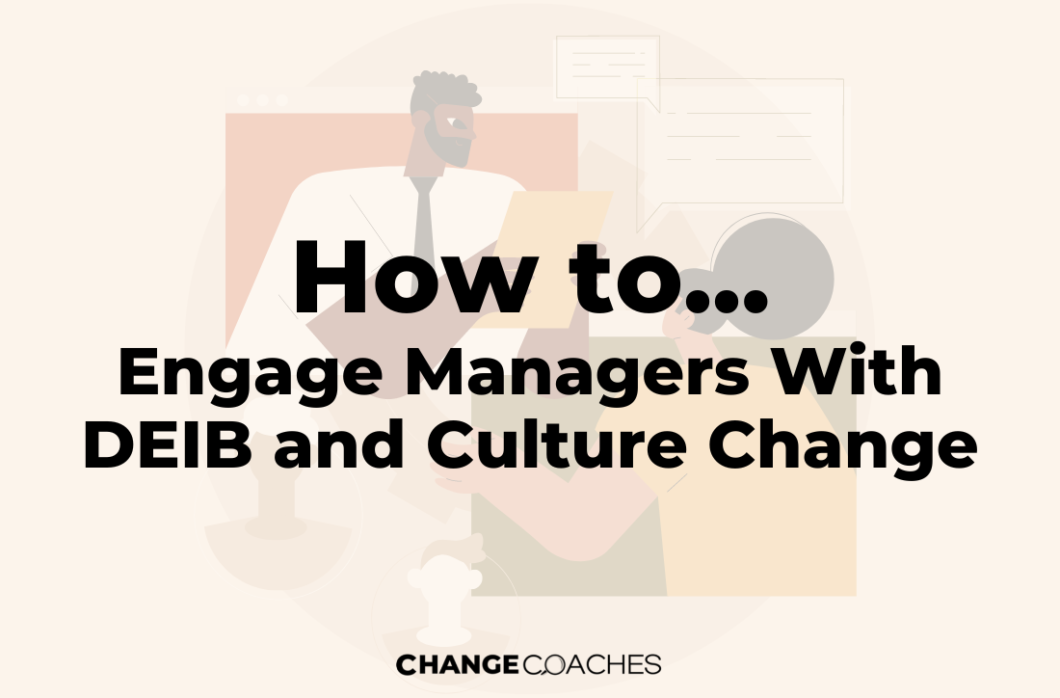Over the last month, I’ve spoken with several organizations still expressing that their DEIB efforts are not resonating with managers. They acknowledged that while leaders are learning to speak the language of DEIB, they felt like their overall organizational efforts had stalled out. Many of you reading this may be experiencing the same thing. So, where does this leave us?
We’ve seen that taking action is necessary, but the convenient and cliche options are not always the most effective. Studies have shown that unconscious bias training doesn’t work and most Chief Diversity Officers are inadvertently set up to fail. Top-down and bottom-up DEIB strategies have created a “frozen middle” in large organizations, and managers in smaller companies have little accountability or support. Organizations that tried “band-aid” solutions for belonging are likely feeling frustrated. Up-and-coming talent who are just coming into the conversation now may be poised to make similar mistakes.
There is no quick fix for diversity and inclusion.
But for organizations large and small, there are two critical sites you can focus on for movement on DEIB goals and culture change: your manager-direct report relationships and your approach to developing them.
I’d like to show you how aligning managerial development approaches with DEIB while incorporating coaching or mentorship in these relationships can support structural and mindset change. I’ll even share a quick tool that all of you can use to get started. If any questions or personal challenges come to mind while you’re reading, please leave a comment so we can have a discussion.

Focus on Mindsets Over Skills
I recently spoke with an executive who requested two unconscious bias “coaching” sessions for just two leaders: one and done. I declined the opportunity because I know this kind of engagement won’t create a mindset shift that will ultimately make a difference. In this case, cramming in new “skills” by themselves won’t make a difference.
I’ve been saying something a lot lately.
At this point we need to focus on mindsets, how we think, over skillsets.
However, many organizations have been laser-focused on DEIB skill sets for some time. They may train you on unconscious bias or how to recruit diverse candidates. But, it’s not enough to get you to actually do these things. You also have to shift your mindset, or your frame of mind around these same topics. It’s one thing to have all of the DEIB knowledge in the world but if your philosophy around how to implement DEIB doesn’t change, then those skills won’t take you very far. For example, many of us have the skills to know what belonging is and what it looks like. But, if our mindsets around belonging don’t shift (i.e. that it’s an essential part of management), then that knowledge in itself isn’t very valuable.
On this same plane, unconscious bias or skills-based training on its own doesn’t provide a comprehensive enough scope to address the deep, personal reflections that need to be made. It’s too shallow of an engagement, and mindset shifts and the behavioral changes that follow need to be reinforced with regular discussions, structures, and systems. Individual employees need to examine their interactions with each other over a period of time to recognize their own judgments and learn to pause before allowing them to influence what they say or do. I don’t see this happening as a result of a one-way training program, which is why I prefer coaching instead. But, regardless, managers are in a great position to provide this kind of mentorship, but they can’t do it alone.
Revisit What You Consider “Manager Fundamentals”
DEIB deserves its own focus alongside other “traditional” manager fundamentals such as strategic planning, time management, and delegation. However, it’s rare that I see this. It’s a big structural miss. DEIB is usually a side dish — an ERG might bring in a speaker or maybe there’s another occasion for an all-company event. I’m not saying these events aren’t important but my question for you is how are you reinforcing these concepts in your core manager development programs? What structures and systems do you have in place to reinforce event learnings? Are managers getting below the surface? How are you shifting mindsets? This is often the part that is missing which is unfortunate because managers are your connectors that guide employees to engage with the structures and systems you’ve created–and they’re an indispensable source that determines how effective they are.
Beyond managerial development, without spending hours getting to know your organization, I can’t tell you what structural changes will make the biggest difference for you. But there are some best practices to follow: Deloitte has found that siloed DEIB programs aren’t as effective as a holistic, embedded strategy or approach. We also know that training usually doesn’t change workplaces unless it is part of a broader effort made up of multiple components. If you can only invest in something small right now, it’s much better to start developing a long-term plan rather than taking shortsighted action. Shift mindsets while making other structural changes to reinforce and support learning. Try asking your managers what their direct reports have been struggling with. You can learn how to phrase this by accessing the tool that I provide at the end of this article.
Evaluate Your Progress
Once you’ve got long-term plans to change mindsets, practices, and structures in motion, it’s time to build in some regular assessment and accountability for that change. Once again, managers are your most valuable partners. It’s hard to assess an individual’s mindset shifts when it comes to their own biases, but you can measure what behaviors and practices are making a difference during one-on-ones and performance reviews through pulse surveys.
Remember that there are four letters in DEIB. I say this because I’ve noticed that some leaders get overwhelmed and burnt out when they feel there’s not enough diversity on their teams, so it’s important to recognize that representation or demographics is just one way to measure success. It’s important to maintain a balanced approach as diversity without inclusion is a disaster — not to mention the effects of a lack of equity or belonging. Recognizing leaders who are having important DEIB conversations and letting them know you appreciate their efforts will go a long way to encourage more belonging-focused mentorship. Don’t throw in the towel if your recruiting efforts aren’t going as desired.
From a relational point of view, here’s what the letters might look like:
Diversity: There is diversity of all types within the organization, people value it, and managers are making an effort to recruit underrepresented individuals.
Equity: People have access to leaders, career development, and all the other resources they need to succeed. Leaders reliably make themselves available through different avenues.
Inclusion: The organization shares power with underrepresented folks, for example, by enabling them to make important decisions.
Belonging: Everyone walks in and feels like they have a place in the organization. There is a sense of interdependence among people on your team.
Again, remember that all of these are important although your organization may be focused on one letter right now.
Free Tool to Get Started: Manager Performance Review Checklist
As you prepare for performance reviews, now is a great time to start gathering information from your managers about where they need support. From there, you can start to think about what shifts you might need to make in your organization. here’s a quick tool you can use:


